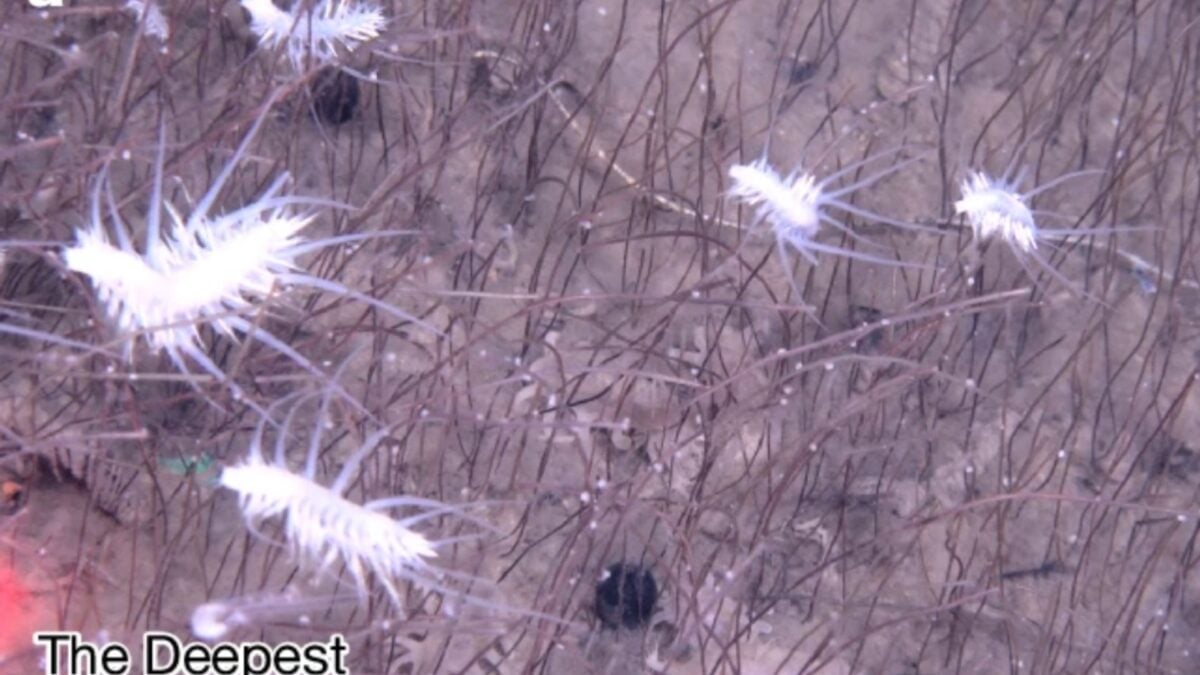Wild Video Captures Alien-Like Creatures Thriving in the Deepest Ocean Ecosystem

Researchers recently dove more than 6 miles beneath the surface of the northwest Pacific Ocean to explore the bottom of two submarine trenches. In this harsh marine environment, they discovered flourishing communities of chemosynthesis-based sea creatures—the deepest and most extensive ones ever found.
The groundbreaking findings, published in the journal Nature on Wednesday, July 30, include photos and footage of the alien-like organisms going about their business in two of the most unforgiving ecosystems on the planet. No light touches the bottom of the Kuril-Kamchatka trench or the Aleutian trench. These organisms survive by converting chemicals to energy rather than food or sunlight. Scientists have long believed that chemosynthesis-based communities are widespread in hadal trenches, but actually finding them has proved challenging, according to the study.
“It’s exciting—especially for a deep sea scientist—to go to a place that human beings have not explored,” lead author Xiaotong Peng, deputy director of the Institute of Deep-sea Science and Engineering at the Chinese Academy of Sciences, told BBC News. “It’s a great opportunity to discover new things. And what we saw was quite amazing.”
[embed]https://www.youtube.com/watch?v=HHhXKrgdApw[/embed]
Hadal trenches are depressions in the seabed that reach depths roughly between 20,000 feet (6,000 meters) and 36,000 feet (11,000 meters). They form along subduction zones where the edge of one tectonic plate slides—or subducts—beneath another. The Kuril-Kamchatka Trench plunges over 31,000 feet (9,600 meters) beneath the ocean surface and stretches from a point off the coast of Hokkaido, Japan, to its intersection with the Aleutian Trench near Russia’s Commander Islands. The Aleutian is slightly less deep, with a maximum depth of about 27,000 feet (8,000 meters), but it’s significantly longer, extending from its intersection with the Kuril-Kamchatka to the Gulf of Alaska.
From July to August 2024, Peng and his colleagues conducted a series of dives aboard a submersible called Fendouzhe. This manned vessel is capable of reaching the deepest parts of the ocean at nearly 36,000 feet (11,000 meters). At the bottom of the trenches, they discovered thriving chemosynthesis-based communities associated with abundant methane seeps—cracks in the seafloor that emit methane gas into the water column.
These communities were dominated by marine tube worms called siboglinid polychaetes and mollusks called bivalves that synthesize energy from fluids rich in hydrogen sulfide and methane. They were extensive, spanning more than 1,500 miles (2,500 kilometers) at depths ranging from roughly 20,000 feet (5,800 meters) to 31,000 feet (9,533 meters).
The discovery challenges the conventional view of hadal ecosystems as being sustained by organic materials sinking from the ocean surface, according to a Nature briefing on the study. This research shows that hadal-seep ecosystems are a hallmark feature of hadal trenches, home to abundant populations of rare chemosynthesis-based species
“As more hadal chemosynthesis-based communities are discovered, we could uncover previously undocumented species, as well as currently unknown interactions between animals and microorganisms that have evolved under the high-pressure conditions of the hadal zone,” the Nature briefing states.









